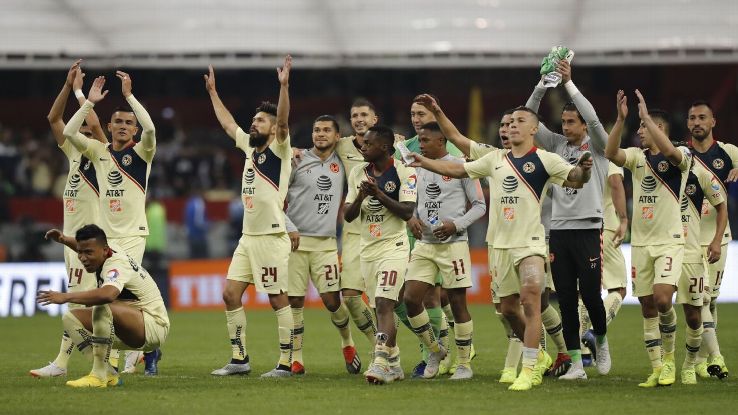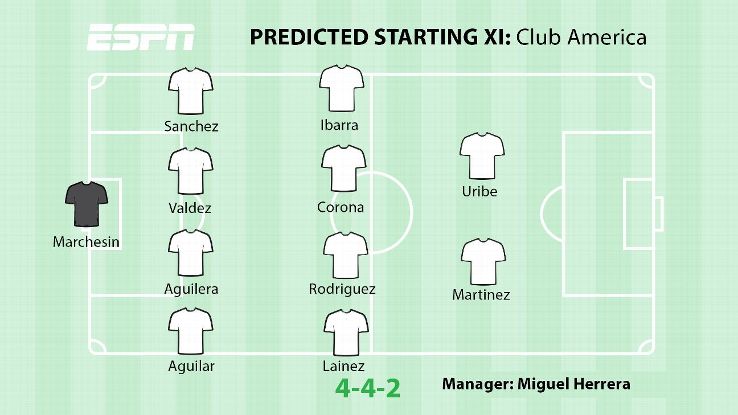
With Club America set take on Cruz Azul in the final of the 2018 Liga MX Apertura, Eric Gomez breaks down Las Aguilas.
MEXICO CITY — Only a few weeks ago, the thought of Club America making the final (and in such a convincing fashion) was somewhat of a pipe dream. Despite the overall solidity of their regular campaign, fans were unimpressed by the team’s lack of a killer forward, its general inability to beat top teams and Miguel Herrera’s tendency to drop back after grabbing a lead.
However, the Mexico City giants went on a blistering postseason run that has seen the team score 12 goals in four games. They have not lost a game since September (in the Copa MX) and will have two games on their home ground to close out the season.
Players to Watch
The key to Club America’s success of late has oddly been one of its perceived weaknesses earlier in the season: their ability to extract offensive contributions from anyone, instead of relying on a focal point up front for scoring. Their leading scorer is Bruno Valdez, a central defender. Valdez and midfielder Guido Rodriguez are key not only for their abilities to contribute on offense, but to manhandle opposing teams in the middle part of the pitch as two of the best defensive players in all of Liga MX.
Wunderkind Diego Lainez has also shown he’s more than able to command the team’s ball movement, he provides an element of the spectacular up front, as shown several times in the semifinal series against Pumas, where he scored twice.
Finally, goalkeeper Agustin Marchesin is often the team’s get out of jail free card, coming up with huge saves when needed and frustrating the other squad’s strikers.
Coaching Style
Miguel Herrera has not been shy about how he likes to dictate play to his opponents in lieu of a traditional possession-oriented attack ending with a classic number nine putting the ball into the net. Wingers Andres Ibarguen, Renato Ibarra and — at times — Lainez are in charge of pushing the ball down the sides with speed.
In their semifinal clash against Pumas, Ibarra demonstrated what the strategy is capable of when at its best. Wingers are encouraged to shoot when they have the chance, to cut inside the box using their skill and look to draw contact, or cross and destabilize the defense with players coming through the middle.
Defensively, Herrera’s only tactical liability has been to drop back towards the end of matches to favor a full counterattacking style with his wingers. At several points this season, the strategy has resulted in America conceding rather than scoring.
Likely Formation
Herrera has reverted at times to his hallmark formation featuring three central defenders and two wingbacks in defense. Other times, he is used a 4-4-1-1 or a malleable 4-4-2. Given Oribe Peralta and Roger Martinez’s difficulty to play together up front, Herrera has eschewed at least one of the two lately to give the team a 5-4-1 formation that can turn into a 3-4-3 with ease, with either wingbacks Jorge Sanchez and Paul Aguilar moving up front, or wingers Ibarguen and Ibarra taking up attacking positions.
A big question for Club America will be whether Herrera uses Lainez from the get go or as a super sub, as has been the case several times this season. Given the coach’s past tendencies, he’ll likely repeat the formation that destroyed Pumas with six goals in the semifinal’s second leg: Marchesin; Sanchez, Valdez, Aguilera, Aguilar; Lainez, Rodriguez, Corona or Uribe, Ibarra; Martinez, Peralta or Uribe.

Intangibles
Two major factors fell into place for Club America this postseason in order to offer them a massive advantage in this final (they boast a 68% chance to win the Apertura, according to the ESPN SPI). By way of the Estadio Azteca’s rent deal with Cruz Azul, Miguel Herrera’s team will now effectively have two home games in the final. Cruz Azul’s fan support has been especially strong this season, but Las Aguilas‘ fandom is rarely surpassed in title deciders.
The other is the opponent itself: Cruz Azul would’ve preferred to face any other team in the Apertura final. Their dramatic Clausura 2013 loss was a backbreaker that still lingers in the memory. Though the possibility for true revenge has been served up on a plate, there’s no doubt the road to snap Cruz Azul’s 21-year drought would have been much easier had they faced any of the other 16 teams in the league.
